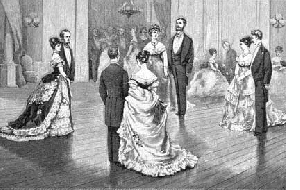4. The Quadrille
 Quadrilles are a class of set dances distinguished by having four (no more, no fewer) couples in a square set. Each couple faced in and formed one side of a square.
Quadrilles are a class of set dances distinguished by having four (no more, no fewer) couples in a square set. Each couple faced in and formed one side of a square.
I call Quadrilles out separately here because they were so incredibly popular in the middle decades of the 19th Century. Some ballcards from the '50s & '60s are almost all Quadrilles.
Quadrilles emerged in the early 19th Century as a rebellion against the simplicity and inclusiveness of the Country Dance. In their early years, they included elaborate steps in addition to complex figures, all of which had to be memorized. It was a dance for an exclusive clique of accomplished dancers.
As the 19th Century progressed, Quadrilles became simpler and more democratic. The skipping "Chasse" traveling step faded away and most dancers were walking through the dance by the mid-19th Century, except when the figure called for a particular step such as a Waltz, Polka, slipping left etc..
Quadrilles incorporated the popular dances of the day. The Waltz was a frequent element and there were also Polka Quadrilles, Mazurka Quadrilles and even Irish jig Quadrilles. Many Quadrilles would include, among their figures, one or more Waltz-based figures, Polka figures etc.
Most Quadrilles consist of 5 distinct figures. Each figure involves the dancers going through some pre-defined set of motions. It often has a "verse" and "chorus" element, with the "chorus" being repeated between each "verse" (the chorus is the same, while the verse changes through the figure). At the time, and today, dance masters did not feel obligated to do all 5 figures, so many Quadrilles were pared down to perhaps three of the "best" (or perhaps easiest) figures. Each individual figure was, essentially, a self-contained dance. It might share a theme with the other four, but you would frequently have one figure with a Waltz element, while another had a Polka or a Mazurka or what ever.
The figures of the Quadrille vary greatly from Quadrille to Quadrille, and many Quadrilles of the same name differ from source to source. However, unlike its later descendent, the Square Dance, the caller did not usually make stuff up as he went along. The figures were pre-set and were generally learned in advance back in the day. Today, they usually have to be prompted.
Each figure, while it may share some elements with the other figures of its Quadrille, should be looked upon a distinctly different dance. Clear your mind of all you have done in previous figures as you undertake each new figure.
I do not, in this brief summary, offer a full explanation of the Quadrille, with it's numerous elements and figures, and were I to do so, I would simply be parroting the work of our Victorian predecessors. So, I will simply suggest that you review some of the many primary source dance manuals currently available online.
Here's one that I have uploaded to my site: The Prompter Quadrille Book. - W B De Garmo 1868
By way of illustration, here's a nice recreation of the ever-popular Parisian Varieties Quadrille by a French group from Marseilles. This dance incorporates Waltz figures along with a Polka figure and a Mazurka/Varsovienne figure.
